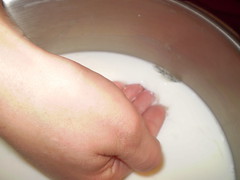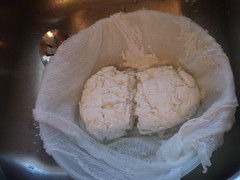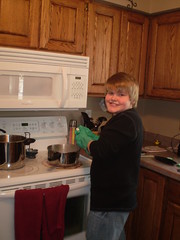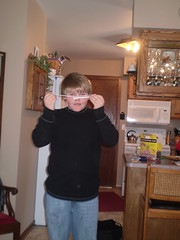Denise and Thomas took a later flight home just so we could make some string cheese before they left Wisconsin. I am so glad that they did. Batch #11 at Grandma and Grandpa (Donna and Jim) Deppeler's house in Windsor was the best so far and it wouldn't have been the same without Thomas' help and enthusiasm.
We started with LW Dairy 1% milk at 10:30 in the morning. We dissolved 1/4 tablet of rennet in 1/2 C of chlorine free water and we dissolved 1 1/2 t. of citric acid into 1 C of chlorine free water.
10:38 am We put one gallon of milk and the citric acid in the pot on the stove at medium to medium-high heat. We put the big pot cheese thermometer (from Albert) and stir frequently, but not vigorously until the milk reached 88 degrees Fahrenheit. At 10:44 it had raised from 45°F to 66°F.
10:50 am We had reached 88°F and we moved the pot off the hot burner and added the rennet. Thomas stirred in the rennet using an up and down motion and we covered the pot to wait 5 minutes. After 5 minutes, the curd appeared to be starting to form, but more time was needed.
11:02 am The curd was formed, but a little soft. We cut the curd in three directions and then used a stainless steel spoon to cut across in layers parallel to the surface of the curd. The whey was separating nicely from the curd.
11:10 am Time to pour off the whey. Unfortunately, we forgot to save some whey and we poured all of the whey down the sink. It would have been better to save about 1 quart for use as our hot water bath that we would need later. After we poured off as much whey as we could without losing curds, we poured the remaining curds and whey into a cheese-cloth lined colander.

We gently rolled the curds back and forth in the cheese cloth to help release as much whey as we could. It's so tempting to squeeze the whey out, but to do so would break down the curd structure that we need to make the cheese.
11:25 am We were ready to cook the curds. We started heating the water bath to 160°F (very hot, but not boiling), we added about 1/2 to 1 C of salt to about 1-2 quarts of water. Grandma gave us some Grey Sea Salt to use for about 1/2 of the salt.
11:30 am We cut the curds in half so I could show Thomas what to do on the first half and he would be able to cook and stretch the second half of the curds. This was a good idea and I will make future string cheese in this way. Working with one half of the curds was much easier for me than my previous efforts with all curds in one batch.
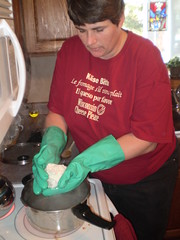
I showed Thomas how to knead the curds into a ball and when it was starting to be easy to stretch and knead it was ready to start stretching for real into string cheese strands. It took only a few minutes to start stretching and I showed him how to keep submerging the cheese into the hot water to keep it hot, but then to take it out before it got too hot to handle.
11:45 am Thomas is ready to make his first batch of string cheese. He donned the green-blue "food grade" gloves to protect his hands from the hot water and got the remaining half of the cheese curds. He did great despite the hot water keeping him moving. He kneaded the ball until it started being easy to stretch. Then, he started stretching it farther and farther and then folding it back in half. He did this over and over, placing the stretched and folded cheese back in the water to heat again. Soon, he had his first tasted of string cheese that he had made himself.
12:00 pm The string cheese was all made. By 12:10 pm it was all eaten. It was by far the best batch of string cheese so far. The string cheese was perfectly salted and we got close to a pound of string cheese from the gallon of milk we started with.
Thanks Thomas, Denise, Mom, and Dad for the great string cheese making event.















